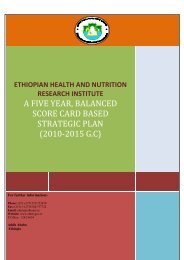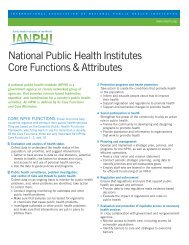Afghanistan Afghan Public Health Institute Strategic Plan - ianphi
Afghanistan Afghan Public Health Institute Strategic Plan - ianphi
Afghanistan Afghan Public Health Institute Strategic Plan - ianphi
You also want an ePaper? Increase the reach of your titles
YUMPU automatically turns print PDFs into web optimized ePapers that Google loves.
Ensure inclusion of deployment data in order for the amalgamated information to show approvedpositions, with details of individuals; (including their qualifications, experience, training received andcost), filling these approved positionsImprove information availability regarding the composition of <strong>Health</strong> Sector Human Resources andbuild relationships with key stakeholders to improve the flow of information within the health sectorrelating to HR requirements, availability, shortages and losses due to attritionSTRATEGIC DIRECTION: INCREASE EQUITABLE ACCESS TO QUALITY HEALTHSERVICESBrief Description/Rationale and Current SituationThere have been marked increases in coverage and access to health services in <strong><strong>Afghan</strong>istan</strong> since 2002,with 57% of the population having access to the Essential Package of <strong>Health</strong> Services (EPHS)(Proceedings from Round Table Meeting on the National Improvement Strategy and Infrastructure forImproving <strong>Health</strong> Care in <strong><strong>Afghan</strong>istan</strong>, January 10, 2010). BPHS coverage has continued to grow fromonly 9% accessibility in 2003 (Multiple Indicator Cluster Survey, 2003) to between 61% (<strong><strong>Afghan</strong>istan</strong><strong>Health</strong> Survey, 2006) and 85% (National Risk and Vulnerability Assessment 2007/08); however, there isstill much to be done.Maternal mortality ratios are the worst in the world (1600 maternal deaths per 100,000 live births,NRVA, 2007‐2008) and Infant and Under 5 mortality rates remain extremely high (111 per 1,000 livebirths; and 161 per 1,000 live births respectively, NRVA, 2007‐2008)The introduction of community midwives and community health workers, in addition to communitynurses, has increased access to health services; however, there is still a need for many more femalehealth workers, particularly in rural and remote areas. “There is (also) a shortage of staff with public health,reproductive health, and child health skills.” (Building on Early Gains …, 2010, pp. 81‐82)There are a number of socio‐cultural barriers to access and utilization that also need to be addressed(refer to study Qualitative Methods in Operation Research on Ways of Overcoming Socio‐cultural Barriers to BirthPreparedness and Newborn Care in Support of Sustained Behavior Change, November 2010, Governance <strong>Institute</strong> –<strong><strong>Afghan</strong>istan</strong> [GI‐A]), to improve access to services, particularly in rural and remote areas.“A quality health care system is client centered, equitable, available, appropriate, safe, consistent, effective, timelyand efficient; it continuously improves.” (MoPH, Strategy for Improving Quality in <strong>Health</strong> Care, 2010). The intentof this <strong>Strategic</strong> Direction is to address the two broad concepts of “access” and “quality”.<strong>Strategic</strong> Objective‐1 (SO‐1): To increase the proportion of people having access to and utilizing theBasic Package of <strong>Health</strong> Services (BPHS)Priority Interventions:Expand coverage of the BPHSAllocate necessary resources and ensure they are used effectively and efficientlyMinistry of <strong>Public</strong> <strong>Health</strong> <strong>Strategic</strong> <strong>Plan</strong>, 2011‐201528




